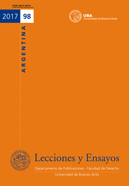Structural violence. Exercise of analysis of the reality of the Wichí, Qom and Pilagá indigenous communities in the Argentine province of Formosa.
Keywords:
structural violence, Formosa, indigenous communities, basic needsAbstract
In the present paper the concept of structural violence of Johan Galtung and his analytical potential is explained. It is applied here to the study of communities and localities Wichí, Qom and Pilagá of the Argentine province of Formosa. The analysis makes visible the marginality in which these communities live, but at the same time emphasizes that it is not possible to make a binary proposal as to the satisfaction or dissatisfaction of basic needs, and therefore of structural violence. It is argued that it is necessary to introduce the variable time and the possibility of graduality in the evaluation of reality. In this way, the description, analysis and criticism on the one hand, and the design of intervention programs, on the other hand, would fit to the specific contexts of reality, and not only to guidelines of general theoretical discourse.
Downloads
References
BAECHELER, Günther, Violence Through Environmental Discrimination. Causes, Rwanda Arena, and Conflict Model, Social Indicators Research Series. Vol. 2, Dordrecht, Springer-Science+Business, Media, B.V, 1999.
BÖHM, María Laura, “Empresas transnacionales y violación de Derechos Humanos en América Latina - Dificultades para su imputación y juzgamiento”, en: Boletín Semestral GLIPGö, 2012, Nro. 4, 11-24.
BÖHM, María Laura, “Transnational Corporations, Human Rights Violations and Structural Violence in Latin America: A Criminological Approach”, en: Kriminologisches Journal, 4/2016, 272-293.
CARTER, Candice C. (ed.), Conflict Resolution and Peace Education. Transformations across Disciplines, Nueva York, Palgrave Macmillan, 2010.
CASALS, Fernando, Formosa. Desde el candil 1879 hasta el alumbrado público de candencia al vacío 1923, Buenos Aires, Ed. Efemérides Comentadas del Autor, 1966.
DE HAAN, Willem, “Violence as an Essentially Contested Concept” en BODY-GENDROT, Sophie y SPIERENBURG, Pieter (ed.), Violence in Europe. Historical and Contemporary Perspectives, Nueva York, Springer, 2008.
GALTUNG, Johan y FISCHER, Dietrich, Johan Galtung – Pioneer of Peace Research, Heidelberg–Nueva York–Dordrecht–Londres, Springer, 2013.
GALTUNG, Johan, Violencia Cultural.Documento de trabajo N° 14, Centro de Investigación por la Paz, Fundación Gernika Gogoratuz, 2003.
––, Frieden mit friedlichen Mitteln. Friede und Konflikt, Entwicklung und Kultur, Serie Friedens- und Konfliktforschung 4, Opladen, Leske+Budrich, 1998.
––, Violencia, Guerra y su impacto, 1998, consultado en [http://red.pucp.edu.pe/wp-content/uploads/biblioteca/081020.pdf].
––, Tras la violencia, 3R: reconstrucción, reconciliación, resolución. Afrontando los efectos visibiles e invisibles de la guerra y la violencia, Bilbao, Bakeaz/Gernika Gogoratuz, 1998.
––, Menschenrechte anders gesehen, Frankfurt, Suhrkamp, 1994.
––, “Visionen einer friedlichen Welt”, en GALTUNG, J., LUTZ, D., RÖHRICH, W., Überleben durch Partnerschaft. Gedanken über eine friedliche Welt, Opladen, Leske + Budrich, 1990.
––, Strukturelle Gewalt, Beiträge zu Friedens- und Konfliktforschung, Reinbek bei Hamburg, Rowohlt Taschenbuch Verlag, 1975.
––, “Eine strukturelle Theorie des Imperialismus” en SENGHAAS, D. (ed.), Imperialismus und strukturelle Gewalt. Analysen über abhängige Reproduktion, Frankfurt, Suhrkamp, 1972.
––, “Violence, Peace, and Peace Research”, en Journal of Peace Research, Vol. 6, n° 3, 1969.
GIRBAL- BLANCHA, Noemí M, Formosa: tierra prometida-tierra arrasada. La Argentina de los márgenes (1884-1955), Texto presentado en el XIV Congreso de Historia Agraria, Sociedad Española de Historia Agraria – Área de Historia e Instituciones Económicas de la Universidad de Extremadura, Badajoz, 7-9 de noviembre de 2013.
GORDILLO, Gastón, Nosotros vamos a estar acá para siempre. Historias tobas, Buenos Aires, Ed. Biblos, 2005.
HEITMEYER, Wilhelm y HAGAN, John (ed.), International Handbook of Violence Research, Dordrecht, Springer, 2003.
HERALDO PRIETO, A. Para comprender Formosa. Una Aproximación a la historia provincial, de Antonio Heraldo Prieto, Formosa, 1990.
KARSTEDT, Susanne, “Democratization and Violence: European and International Perspectives”, en BODY-GENDROT, Sophie y SPIERENBURG, Pieter (ed.), Violence in Europe. Historical and Contemporary Perspectives, Springer, 2009.
MANSILLA, Lucio V., Una excursión a los indios ranqueles, edición Agebe, 2012.
MAPELMAN, Valeria, Octubre Pilagá. Memorias y archivos de la masacre de La Bomba, Tren en movimiento, Buenos Aires, 2015.
MARTÍNEZ SARASOLA, Carlos, Nuestros paisanos los indios. Vida, historia y destino de las comunidades indígenas en Argentina, Buenos Aires, Del Nuevo Extremo, 2013.
MIDRÉ, Georges FLORES, Sergio, Élite ladina, políticas públicas y pobreza indígena, Instituto de Estudios Interétnicos – Universidad San Carlos de Guatemala, Magna Terra, Guatemala, 2012.
MORRISON, Wayne, ZAFFARONI, Eugenio Raúl y BERGALLI, Roberto, “Diálogos sobre criminología, genocidio y daño social con Wayne Morrison, Eugenio Raúl Zaffaroni y Roberto Bergalli”, en RIVERA BEIRAS, Iñaki (Ed.), Delitos de los Estados, de los Mercados y daño social, Barcelona, Ed. Anthropos, 2014.
RIVERA BEIRAS, Iñaki, “Retomando el concepto de violencia estructural. La memoria, el daño social y el derecho a la Resistencia como herramientas de trabajo”, RIVERA BEIRAS, I. (Ed.), Delitos de los Estados, de los Mercados y daño social, Barcelona, 2014.
SHARP, Dustin N., Justice and Economic Violence in Transition, SHARP, D. N. (ed.), Springer, 2014.
SHINKEL, Willem, Aspects of Violence. A critical Theory, Basingstoke, Ed. Palgrave Macmillan, 2010.
SLUTZKY, Daniel, Estructura social agraria y agroindustrial del Nordeste de la Argentina: desde la incorporación a la economía nacional al actual subdesarrollo concentrador y excluyente, IADE, Buenos Aires, 2011.
TUASON, María Teresa, “Peace Psychology in a Poor World: Conflict Transformation in Response to Poverty”, en CARTER, Candice (ed.), Conflict Resolution and Peace Education. Transformations across Disciplines, Palgrave, 2010.
Downloads
Published
How to Cite
Issue
Section
License

This work is licensed under a Creative Commons Attribution-NonCommercial 4.0 International License.











